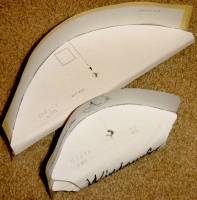
Reflector: Angled
gnuplot file.
PDF of the reflector.
I used my foil between sheets of paper method I mentioned earlier. Insulating the reflector so it doesn't get grounded or something is a really good idea.
My parabola is noticably bigger than the windsurfer. (Windsurfer can be enlarged in a paint program but you may want to vertically smash the reflector rectangle to keep it from getting just way too big.)
With stiff paper, the larger reflector tends to have an easier time curving (apparent in one pic).
Windsurfer and mine have a similar width to depth ratio for this test. This means they will behave similarly except for the surface area for RF collection.
For real world performance testing, I don't have wifi but just a little USB Bluetooth dongle. The numbers here are relative to whatever internal format hcitool reports under linux. Rubber duck is about 2.75 inches long (half wave for 2.4GHz, I believe).
I have a lot of metal and computers in this room (I can't see most of my walls). This room is far from anechoic. I had some whacky polarization problems. The first round of tests wanted vertical, the second round wanted horizontal. The reported numbers were about the same for both testing rounds.
I used my Bluetooth headset (run off big batteries) for the remote antenna. From dongle to headset was about 5 feet direct line of sight. The headset has an internal antenna traced on the PCB that is a similar length to the duck.
The numbers. The rubber ducky antenna alone gave a reading of about 9. If I move the rubber duck 90 degrees out of proper polarization, I'd get 3-5. Windsurfer would get around 17 with proper polarization. My parabola would get around 21 with proper polarization. The reflector off axis but still in visible line of rubber duck sight would get a hair less than the non-reflected duck. To add a little perspective, the lone rubber duck would get around 17 at a third of that distance (a bit under 2 feet).
Leftovers. After I did the initial cut out I realized I could make a cradle type reflector for something like my cell phone. This looks really ghetto since it was an after thought. (3rd picture above)
For something like this to be practical, it will need to be made out of a very heavy paper/cardboard to support the phone. In this example, speaker phone or a headset will need to be used. DO NOT put this to your head and reflect back that little 2 watt transmitter into your brain (idiots have been warned).
The spacer the cell phone is resting on is a little before the parabolic focus. This is needed for the extra space the plastic casing will give.
I normally get really good signal in my area so this was kinda hard to practically test. If I did point the reflector away from the tower or rotate to the wrong polarization, the signal bars did go down.